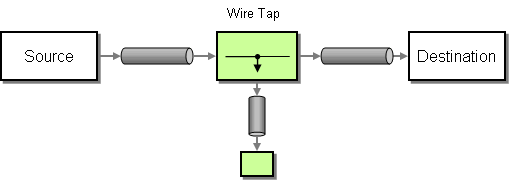Fuse 6 is no longer supported
As of February 2025, Red Hat Fuse 6 is no longer supported. If you are using Fuse 6, please upgrade to Red Hat build of Apache Camel.10.3. Wire Tap
Wire Tap
Copy linkLink copied to clipboard!
The wire tap pattern, as shown in Figure 10.1, “Wire Tap Pattern”, enables you to route a copy of the message to a separate tap location, while the original message is forwarded to the ultimate destination.
Figure 10.1. Wire Tap Pattern
Streams
If you Wire Tap a stream message body, you should consider enabling Stream Caching to ensure the message body can be re-read. See more details at Stream Caching
WireTap node
Copy linkLink copied to clipboard!
Apache Camel 2.0 introduces the
wireTap node for doing wire taps. The wireTap node copies the original exchange to a tapped exchange, whose exchange pattern is set to InOnly, because the tapped exchange should be propagated in a oneway style. The tapped exchange is processed in a separate thread, so that it can run concurrently with the main route.
The
wireTap supports two different approaches to tapping an exchange:
- Tap a copy of the original exchange.
- Tap a new exchange instance, enabling you to customize the tapped exchange.
Tap a copy of the original exchange
Copy linkLink copied to clipboard!
Using the Java DSL:
from("direct:start")
.to("log:foo")
.wireTap("direct:tap")
.to("mock:result");
from("direct:start")
.to("log:foo")
.wireTap("direct:tap")
.to("mock:result");
Using Spring XML extensions:
Tap and modify a copy of the original exchange
Copy linkLink copied to clipboard!
Using the Java DSL, Apache Camel supports using either a processor or an expression to modify a copy of the original exchange. Using a processor gives you full power over how the exchange is populated, because you can set properties, headers and so on. The expression approach can only be used to modify the In message body.
For example, to modify a copy of the original exchange using the processor approach:
And to modify a copy of the original exchange using the expression approach:
from("direct:start")
.wireTap("direct:foo", constant("Bye World"))
.to("mock:result");
from("direct:foo").to("mock:foo");
from("direct:start")
.wireTap("direct:foo", constant("Bye World"))
.to("mock:result");
from("direct:foo").to("mock:foo");
Using the Spring XML extensions, you can modify a copy of the original exchange using the processor approach, where the
processorRef attribute references a spring bean with the myProcessor ID:
<route>
<from uri="direct:start2"/>
<wireTap uri="direct:foo" processorRef="myProcessor"/>
<to uri="mock:result"/>
</route>
<route>
<from uri="direct:start2"/>
<wireTap uri="direct:foo" processorRef="myProcessor"/>
<to uri="mock:result"/>
</route>
And to modify a copy of the original exchange using the expression approach:
Tap a new exchange instance
Copy linkLink copied to clipboard!
You can define a wiretap with a new exchange instance by setting the copy flag to
false (the default is true). In this case, an initially empty exchange is created for the wiretap.
For example, to create a new exchange instance using the processor approach:
Where the second
wireTap argument sets the copy flag to false, indicating that the original exchange is not copied and an empty exchange is created instead.
To create a new exchange instance using the expression approach:
from("direct:start")
.wireTap("direct:foo", false, constant("Bye World"))
.to("mock:result");
from("direct:foo").to("mock:foo");
from("direct:start")
.wireTap("direct:foo", false, constant("Bye World"))
.to("mock:result");
from("direct:foo").to("mock:foo");
Using the Spring XML extensions, you can indicate that a new exchange is to be created by setting the
wireTap element's copy attribute to false.
To create a new exchange instance using the processor approach, where the
processorRef attribute references a spring bean with the myProcessor ID, as follows:
<route>
<from uri="direct:start2"/>
<wireTap uri="direct:foo" processorRef="myProcessor" copy="false"/>
<to uri="mock:result"/>
</route>
<route>
<from uri="direct:start2"/>
<wireTap uri="direct:foo" processorRef="myProcessor" copy="false"/>
<to uri="mock:result"/>
</route>
And to create a new exchange instance using the expression approach:
Sending a new Exchange and set headers in DSL
Copy linkLink copied to clipboard!
Available as of Camel 2.8
If you send a new messages using the Wire Tap then you could only set the message body using an Expression from the DSL. If you also need to set new headers you would have to use a Processor for that. So in Camel 2.8 onwards we have improved this situation so you can now set headers as well in the DSL.
The following example sends a new message which has
- "Bye World" as message body
- a header with key "id" with the value 123
- a header with key "date" which has current date as value
Java DSL
Copy linkLink copied to clipboard!
XML DSL
Copy linkLink copied to clipboard!
The XML DSL is slightly different than Java DSL as how you configure the message body and headers. In XML you use <body> and <setHeader> as shown:
Using onPrepare to execute custom logic when preparing messages
Copy linkLink copied to clipboard!
Available as of Camel 2.8
For details, see Multicast.
Options
Copy linkLink copied to clipboard!
The
wireTap DSL command supports the following options:
| Name | Default Value | Description |
|---|---|---|
uri
|
The endpoint uri where to send the wire tapped message. You should use either uri or ref.
|
|
ref
|
Refers to the endpoint where to send the wire tapped message. You should use either uri or ref.
|
|
executorServiceRef
|
Refers to a custom Thread Pool to be used when processing the wire tapped messages. If not set then Camel uses a default thread pool. | |
processorRef
|
Refers to a custom Processor to be used for creating a new message (eg the send a new message mode). See below. | |
copy
|
true
|
Camel 2.3: Should a copy of the Exchange to used when wire tapping the message. |
onPrepareRef
|
Camel 2.8: Refers to a custom Processor to prepare the copy of the Exchange to be wire tapped. This allows you to do any custom logic, such as deep-cloning the message payload if that's needed etc. |
